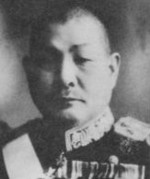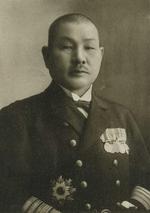Soemu Toyoda
| Surname | Toyoda |
| Given Name | Soemu |
| Born | 22 May 1885 |
| Died | 22 Sep 1957 |
| Country | Japan |
| Category | Military-Sea |
| Gender | Male |
Contributor: C. Peter Chen
ww2dbaseSoemu Toyoda was born in the district of Oita in Japan in 1885. Early in his life he found a love for the unpredictability and the challenging nature of the sea, which prompted him to enroll in the Naval Academy. He graduated from the academy in 1905, becoming an expert in naval gunnery. His early career saw him aboard destroyers and cruisers, as well as tours to Britain, which included his attendance of the London Naval Conference with Isoroku Yamamoto in 1931. He reached flag rank on 1 Dec 1931 when he was promoted to rear admiral and became a member of the naval staff. After several desk assignments, Toyoda returned to sea-going duty as the commanding officer of the 4th Fleet then the 2nd Fleet, both in support of the invasion of China. He was one of the naval officers who opposed war with the United States. He "felt at the time that [Japan] could have avoided the war if it had tried hard enough", he said during his interrogation after the war. However, he also deeply believed that it was not a military serviceman's place to become involved in politics, so like so many others he obeyed his orders obediently.
ww2dbaseAt the time of the Pearl Harbor attack, Toyoda was the admiral in charge of the Kure Naval Station. The appointment of that position returned him back on land for the remainder of his career. In Nov 1942, he became a member of the Supreme War Council; his most notable action item at this appointment, although ending largely in failure when presented to the army-dominated Imperial General Headquarters, was his attempt to dedicate a greater percentage of Japan's industrial capacity to construct aircrafts for the navy. In May 1943 he left the Supreme War Council and took command of the Yokosuka Naval Base.
ww2dbaseToyoda's career reached its peak on 3 May 1944 when he was appointed the Commander-in-Chief of the Combined Fleet, succeeding the recently deceased Admiral Mineichi Koga. At the helm of the Combined Fleet, Toyoda's A-Go Operation resulted in a major depletion of Japanese naval airpower at the Philippine Sea, and the subsequent Sho-Go Operation saw a complete annihilation of ships at Surigao Strait dealt by Rear Admiral Jesse Oldendorf and a disheartening loss of the battleship Musashi by swarming aircraft. Toyoda knew Sho-Go was a big gamble, but he also felt that had he preserved the naval strength by allowing the Americans to take the Philippines and cut off Japanese shipping to the south, the ships would soon run out of fuel, therefore it did not make sense to him to not go on this risky endeavor. "[I]f things went well, we might obtain unexpectedly good results", said Toyoda, "but if the worst should happen, there was a chance that we would lose the entire fleet. But I felt that that chance had to be taken." During the Marianas and Leyte Gulf campaigns (A-Go and Sho-Go operations, respectively), Japanese airmen and naval crew reported inflated reports on damages inflicted on the enemy, a common practice by both sides during the Pacific War. Toyoda, unlike his American counterparts, bought into his own propaganda which was based on these inflated numbers. Thinking that the American naval power was hurt much beyond actuality, when encountered with a need for a defense plan for the Philippines, Toyoda called for reinforcement of Leyte from Luzon and China, naming Leyte the location of the decisive battle that would stop the American juggernaut. In hindsight, this aggressive defensive strategy did not pay off; in comparison, General Tomoyuki Yamashita's plan to make Luzon the site of the final defensive stand was more advantageous, especially given the proof that Yamashita was able to continue his resistance on Luzon until the day of Japan's surrender.
ww2dbaseToyoda, despite meeting unfavorable outcomes with his previous operations, nevertheless continued with his aggressive plans. He sent battleship Yamato on a suicidal mission with the goals of sinking the fleet supporting the landing operations at Okinawa. That operation, Ten-Go, saw the end of the Yamato in a eerie deja vu of the Dec 1941 sinking of the HMS Repulse and HMS Prince of Wales by overwhelming airpower. While the sinking of Repulse and Prince of Wales marked the end of pre-war British naval presence in south Pacific, the sinking of the Yamato symbolized the end of the once unstoppable Japanese navy. In May 1945, he stepped down from his position as the commanding officer of the Combined Fleet and became the head of Overall Naval Command and then Chief of Naval General Staff.
ww2dbaseIn the last days of the war, while the dovish Prince Konoye lobbied for methods to negotiate for peace, Toyoda argued to defend the home islands until the last man. This argument persisted even after the dropping of atomic bombs by the United States and the declaration of war on Japan by Russia. After the war, he was interrogated by Rear Admiral R. A. Ofstie of the United States Navy, Major General O. A. Anderson of the United States Army, and Lieutenant Commander W. Wilds of the United States Naval Reserves in Tokyo on 13 and 14 Nov 1945. He was commented as "highly intelligent and widely informed", and was observed to be a strong critic of the amount of political power the Army held in the Japanese government. He also expressed his opinion that the war with China should have been ended "even at some sacrifice" so that the men and resources could be redeployed to the Pacific theater. At the war trials, he was released under the condition that he would never enter public service (same condition was required of for all released war criminals).
ww2dbaseToyoda passed away in Tokyo on 22 Sep 1957. His memoirs were published in 1950.
ww2dbaseSources: Interrogations of Japanese Officials, the Pacific Campaign, Spartacus Educational, Wikipedia.
Last Major Revision: Mar 2007
Photographs
 |  |
Soemu Toyoda Timeline
| 22 May 1885 | Soemu Toyoda was born. |
| 18 Sep 1941 | Admiral Soemu Toyoda was named the commanding officer of Kure Naval District, Japan. |
| 10 Nov 1942 | Admiral Soemu Toyoda stepped down as the commanding officer of Kure Naval District, Japan. |
| 3 May 1944 | Soemu Toyoda was named the commander-in-chief of the Japanese Navy Combined Fleet. |
| 22 Sep 1957 | Soemu Toyoda passed away. |
Please consider supporting us on Patreon. Even $1 per month will go a long way! Thank you. Please help us spread the word: Stay updated with WW2DB: |
Visitor Submitted Comments
22 Feb 2012 11:15:22 AM
It would be great to find out if he had children
All visitor submitted comments are opinions of those making the submissions and do not reflect views of WW2DB.
» Hyuga
» Oyodo
Document(s):
» Interrogation Nav 75, Admiral Soemu Toyoda
- » 1,165 biographies
- » 337 events
- » 44,601 timeline entries
- » 1,243 ships
- » 350 aircraft models
- » 207 vehicle models
- » 376 weapon models
- » 123 historical documents
- » 261 facilities
- » 470 book reviews
- » 28,615 photos
- » 429 maps
Lt. Gen. Lewis B. "Chesty" Puller, at Guadalcanal
Please consider supporting us on Patreon. Even $1 a month will go a long way. Thank you!
Or, please support us by purchasing some WW2DB merchandise at TeeSpring, Thank you!
4 May 2011 03:28:39 PM
Does anyone know, did the Admiral have any sons and if so, what were their names and dates of birth? I may be able to link him to a Toyoda I know.